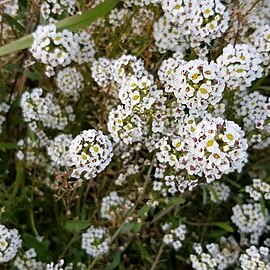Plants not scapose; pubescent, trichomes appressed, unicellular, medifixed. Stems erect, procumbent, or decumbent [ascending], branched basally [and distally]. Leaves cauline; not rosulate; blade (base not auriculate), margins entire. Racemes (several-flowered, sometimes bracteate at base). Fruiting pedicels ascending [divaricate], slender. Flowers: sepals oblong [ovate]; petals obovate [spatulate or orbicular], claw differentiated from blade, (margins entire, apex often rounded); stamens slightly tetradynamous; filaments dilated basally; anthers ovate, (apex obtuse); nectar glands (8): 4 lateral (rudimentary), 4 median (cylindrical). Fruits sessile or shortly stipitate, elliptic-suborbicular [orbicular, obovate, elliptic], smooth, convex, latiseptate; valves (papery), each 1-veined, pubescent; replum rounded; septum complete; ovules 2-10 per ovary; stigma capitate. Seeds uniseriate or biseriate, strongly flattened, winged or not, lenticular or ovate [orbicular]; seed coat (reticulate), mucilaginous when wetted; cotyledons accumbent. x = 11, 12, 23.
Annual or perennial taprooted herbs. Hairs appressed, parallel, medifixed. Stems ascending, leafy. Lvs narrow, entire. Racemes ebracteate. Sepals spreading, not saccate. Petals white, rarely red or purple. Stamens 6, without appendages. Lateral nectaries 4, median 2, filiform, between stamen bases. Style short; stigma capitate. Silicle circular or ovoid, latiseptate; valves slightly inflated, with median and weak lateral veins. Seeds ellipsoid, narrowly winged, 1-5 per locule.
Pet white or lavender purple, with slender claw and broadly rounded blade; short filaments flanked on each side by a pair of glands of different size; anthers short and blunt; ovary ovoid, with 1–8 ovules per locule; style very short; fr orbicular to ovate, flattened parallel to the septum; style persistent; herbs with entire lvs, ± pubescent with 2-pronged hairs longitudinally appressed to the stem and branches. 4, mostly Mediterranean.
Annual or perennial herbs, usually hairy. Sepals equal, spreading. Petals short, clawed. Stamens not appendiculate. Nectariferous glands short, filiform, on both sides of lateral stamens and on inner side of median stamens. Stigma capitate. Silicula dehiscent, latisept; valves with a midvein. Seeds 1 per locule.

